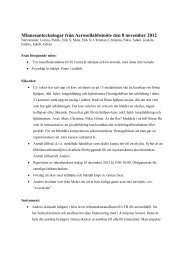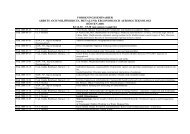ESTIMATING CLOUD DROPLET EFFECTIVE RADIUS ... - CAST
ESTIMATING CLOUD DROPLET EFFECTIVE RADIUS ... - CAST
ESTIMATING CLOUD DROPLET EFFECTIVE RADIUS ... - CAST
- No tags were found...
Create successful ePaper yourself
Turn your PDF publications into a flip-book with our unique Google optimized e-Paper software.
<strong>ESTIMATING</strong> <strong>CLOUD</strong> <strong>DROPLET</strong> <strong>EFFECTIVE</strong> <strong>RADIUS</strong> FROM SATELLITE REFLECTANCE DATAModified Exponential Approximation___________________________________________________________________________________________________3. RESULTS and DISCUSSIONFour runs were performed, with different initial conditions for the reflectance in the 2.1 µmband(R 2 ) and optical thickness in the visible (τ 1 ). The results are summarized in table 2 and 3.Figure 6 illustrates the droplet size distribution in the four runs.It is obvious that lower set up conditions result in more pixels being calculated. Lowreflectance in the second waveband results in values τ 1 and τ 2 as low as 3.6 (R 2 > 0.25) and2.6 (R 2 > 0.2), and mode optical thickness at 8 and 5 respectively. Since the model is suitedfor clouds with optical thickness > 10, this implies that the model is not applicable to pixleswith R 2 -values < 0.3, where the optical thickness appears to be too small. For R 2 > 0.3 theoptical thickness lies in the range 4.6 – 50.9, with mode optical thickness at 13, which isacceptable.Many pixels in the first two runs, with R 2 > 0.2, result in much larger r e –values than in thelast two runs. Maximum effective radius is at 27(20) µm for R 2 > 0.2(0.25) and 15.5 for R 2 >0.3 (Table 3, Figure 8). Also the median and mode effective radius is higher in the first tworuns. The last two runs produced median and mode effective radius at 14.6 and 15 µmrespectively, which is in line with the expected result.The results can be compared with results from Rosenfeld and Lensky (1998). According toRosenfeld and Lensky the cloud top median of effective radius is 14 µm for clouds near thecoastline and 9 µm over inland, therefore both 20(17) µm (R 2 > 0.2(0.25)) and 14.6 µm (R 2 >0.3) appear relatively high for median value for continental clouds. However, one should bearin mind that the continental area studied by Rosenfeld and Lensky covers southern Malaysiaand central Sumatra. Southern Sweden is thus relatively small in comparison and most partscan be considered to be located near the coastline. The areas over Malaysia and Sumatra alsohave higher population density. Likely the air is more polluted (due to traffic and forestburning) here than over southern Sweden. If so, the retrieved median value of 14.6 µm,although higher than 9 µm, is realistic. Still, the median effective radius of 17-19 µm, fromthe first two runs, can be considered overestimated, confirming that the model is not suitablewhere R 2 < 0.3. Thus, the results from this study are in agreement with the same fromRosenfeld and Lensky (1998). It is interesting that the use of the 2.1 µm waveband instead ofthe 3.7 µm (as in the study by Rosenfeld and Lensky) cause no major differences in theresults.Table 3 Summary over the results of optical thickness τ from the four runs. Since the only difference betweenthe two last runs is the restriction of τ 1 , the statistics of τ are identical, why both cases of τ 1 for R 2 > 0.3 arerepresented in the last row.conditionsTotal no. ofpixels computedmin τ max τ median τ 1 median τ 2 mode τR 2 > 0.2 3903 2.65 65.42 9.52 9.89 5R 2 > 0.25 1721 3.61 68.25 10.95 11.10 8R 2 > 0.3 202 4.62 48.64 10.91 11.43 1320




